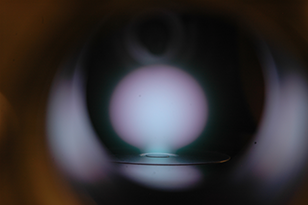Photograph of a fireball above a positively biased electrode in a low-temperature plasma experiment at Sandia National Laboratory. Fireballs are secondary discharges that form near positively biased electrodes in partially ionized plasmas because the electric field near the electrode accelerates electrons to high energy, which rapidly increases the ionization rate. Photograph taken by Dr. Benjamin Yee.
Plasmas in all industrial devices and experiments are in contact with the material walls that confine them, and it is often the interaction of plasma with a material that is responsible for producing a desired outcome. As a dramatic example, it is a requirement of magnetic fusion energy to confine a 100 million degree plasma inside a material wall without destroying it. In another, plasma processing of materials enables many of the technologies that we use in modern society, including surface modification and the manufacture of integrated circuits at the nanoscale. Nearly a century of research has revealed that the interaction between plasmas and other materials is a complicated nonlinear interaction that depends on many things, such as the plasma conditions, geometry, chemistry, electrical and magnetic configurations and boundary materials. Our research explores new ways in which boundaries can be used to control plasma properties for desired outcomes, as well as to develop a better understanding of the complex interaction between plasmas and materials in an effort to improve plasma-based technologies.
Ion Sheaths
Plasmas consist of equal numbers of positively charged particles (ions) and negatively charged particles (electrons), so that overall they are charge neutral. However, the electrons are typically much lighter than the ions, and as a result they want to diffuse out of the plasma much more quickly. When this charge separation occurs, a strong electric field is generated that pulls most of the electrons back toward the ions. After a steady-state is reached, the net result is that a strong electric field called a sheath forms in a very thin region (a sort of skin) surrounding the plasma. Sheaths act to balance the electron and ion currents lost from a plasma.
The most common type of sheath is an ion sheath, meaning it contains more ions than electrons. This is the common situation because ion sheaths act to reflect electrons back into a plasma, while accelerating ions out of the plasma into the material boundary. These sheath-accelerated ions are often used to do useful things to the materials that they strike.
Our research in this area has focused on describing the ion energy distribution near sheaths [B7,B11], and understanding the nature of the region near sheaths (called the presheath) when there are multiple species of ions present [B5,B6,B10,B13,B14]. One discovery is that multiple ion species produce instabilities, called two-stream instabilities, that significantly influence the speed at which ions leave the plasma. Specifically, the instabilities cause a rapid increase in the friction force felt between the different species as they flow toward the boundary. This instability-enhanced friction slows down the lighter ion species and speeds up the heavier one. Ion-acoustic instabilities can also form near the sheath of single ion species plasmas, and can influence both the ion and electron energy distributions [B4,B7,B11].
Electron Sheaths
Although ion sheaths are the most common sheath to form naturally, electron sheaths can be generated by biasing a small electrode more positive than the plasma potential [B2]. Electron sheaths are thin regions of negative space charge that act to accelerate electrons out of a plasma (toward a boundary), and reflect ions back into a plasma. They can be utilized to do a number of useful things, including making electron sources [B1], and controlling plasma properties [B9,B15]. Although ion sheaths have been studied for nearly a century, much less is known about electron sheaths. Recent research has found that pressure gradients near electron sheaths accelerate electrons to very high speeds before they reach the sheath itself [B12]. This acceleration region extends far into a plasma, revealing that electron sheaths have a non-local character that was not previously recognized.
Fireballs & Double Layers
When an electrode producing an electron sheath is biased significantly above the plasma potential, it has been observed that a secondary discharge can form that is much brighter than the ambient plasma (see the photo above) [B3]. This phenomenon has been called an anode double layer, fireball, anode spot and plasma contactor. It is not very well understood, but is believed to be formed by increased ionization near the electrode due to the acceleration of fast electrons in the electron sheath. They have been observed to have spherical or cylindrical shapes, and measurements have shown that a strong electric field, called a double layer, surrounds the bright region. This double layer separates plasmas of different properties (inside and outside the spot), and is similar to a sheath near a material boundary. Our research seeks a basic understanding of this phenomenon, including determining what causes the onset, shape, double layer properties, plasma conditions inside and near the spot, as well as to explore useful applications of this interesting phenomenon.

